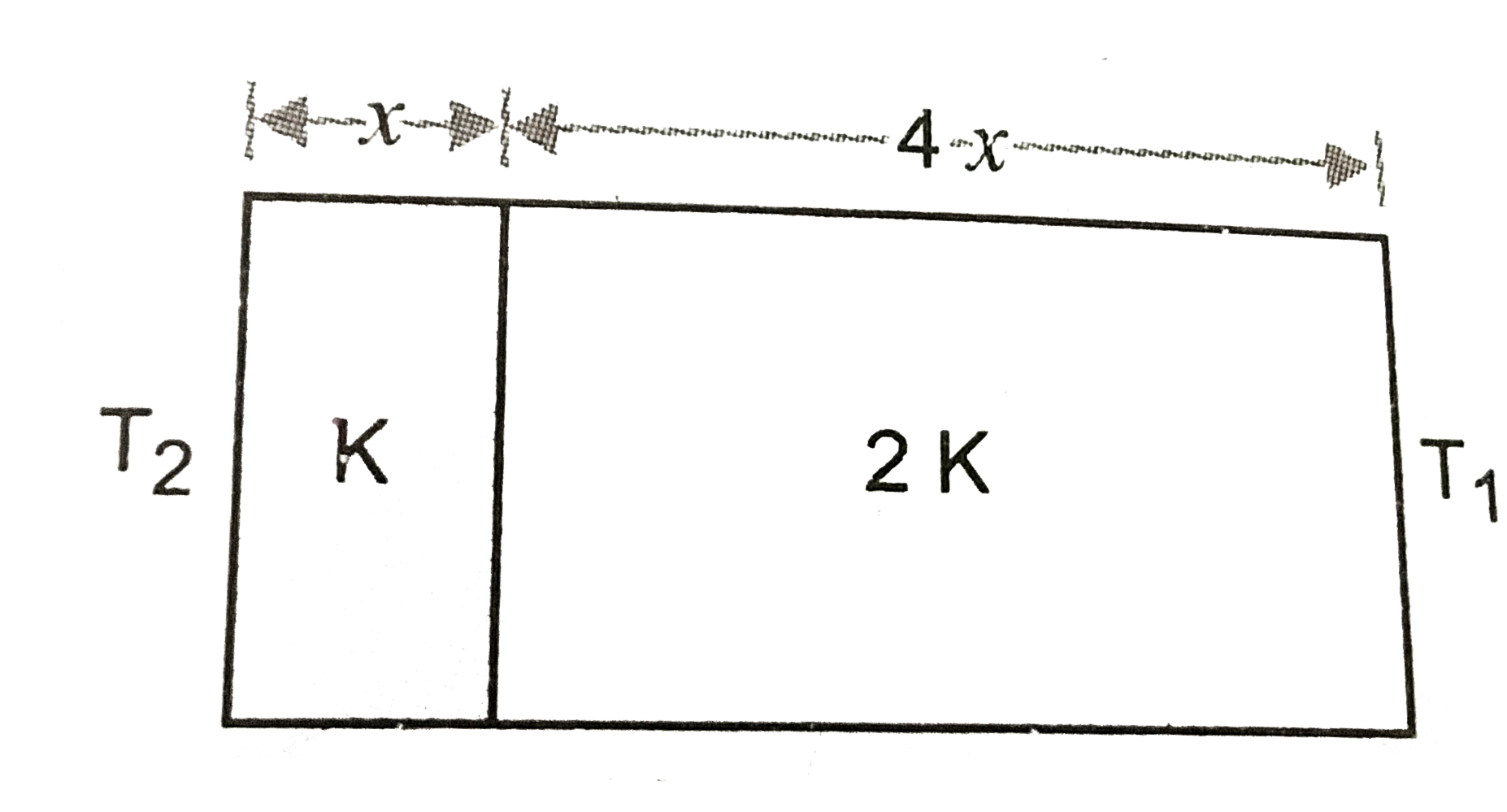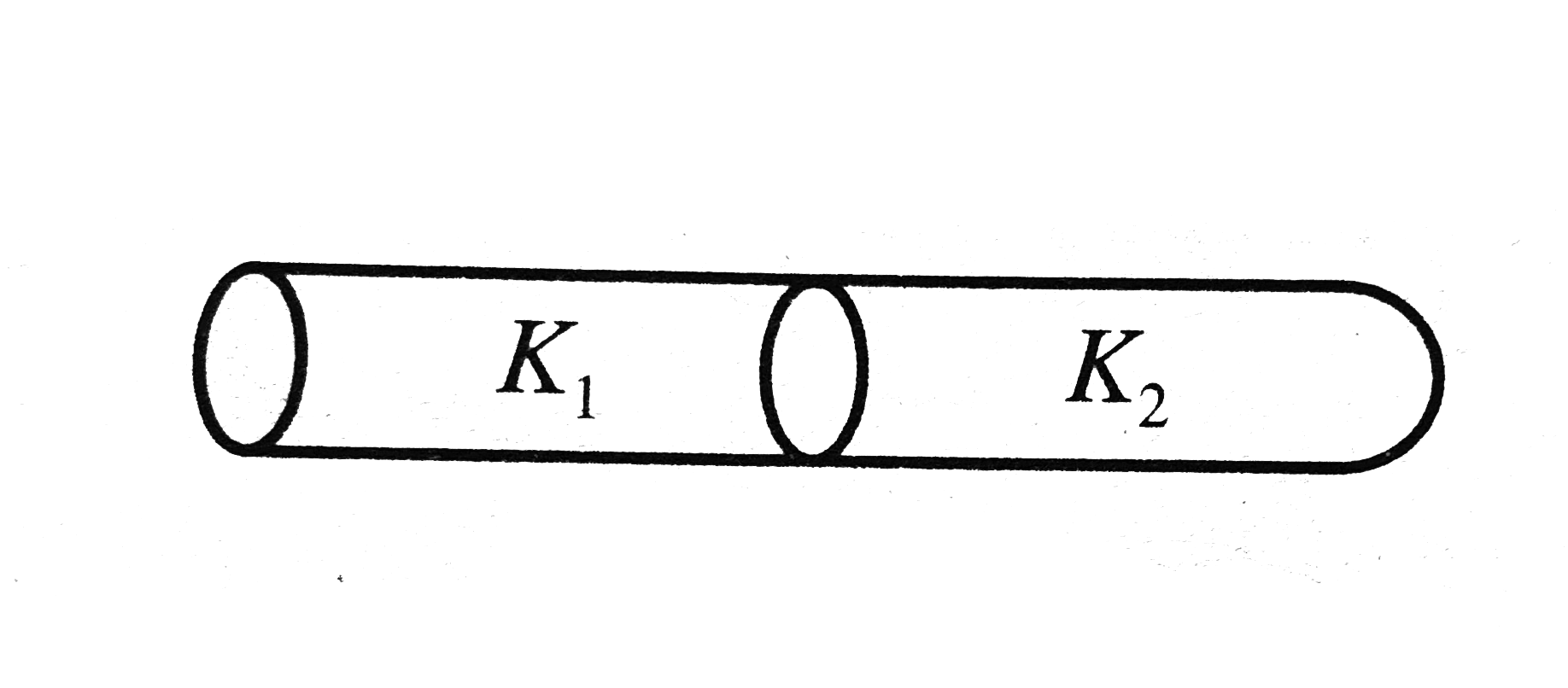Consider a compound slab consisting of two different material having equal thickness and thermal conductivities K and 2K respectively. The equivalent thermal conductivity of the slab is
2/3K
(b) √2K
3K
(4/3)K
The correct Answer is:D
To solve the problem of finding the equivalent thermal conductivity of a compound slab consisting of two materials with thermal conductivities K and 2K, we can follow these steps:
1. Identify the Properties of the Slabs:
- Let the thickness of each slab be l.
- The thermal conductivity of the first slab is K.
- The thermal conductivity of the second slab is 2K.
2. Calculate the Thermal Resistance of Each Slab:
- The thermal resistance R for a slab is given by the formula:
R=lK⋅A
- For the first slab (conductivity K):
R1=lK⋅A
- For the second slab (conductivity 2K):
R2=l2K⋅A
3. Combine the Thermal Resistances:
- Since the slabs are in series, the total thermal resistance Rtotal is the sum of the individual resistances:
Rtotal=R1+R2=lK⋅A+l2K⋅A
4. Find a Common Denominator:
- To combine the fractions, find a common denominator:
Rtotal=2l2K⋅A+l2K⋅A=2l+l2K⋅A=3l2K⋅A
5. Relate Total Resistance to Equivalent Conductivity:
- The equivalent thermal resistance can also be expressed in terms of the equivalent thermal conductivity Keq:
Rtotal=lKeq⋅A
- Setting the two expressions for Rtotal equal gives:
3l2K⋅A=lKeq⋅A
6. Solve for the Equivalent Thermal Conductivity:
- Cancel l and A from both sides:
32K=1Keq
- Taking the reciprocal gives:
Keq=2K3
Final Result:
The equivalent thermal conductivity of the compound slab is:
Keq=43K
- Let the thickness of each slab be l.
- The thermal conductivity of the first slab is K.
- The thermal conductivity of the second slab is 2K.
- The thermal resistance R for a slab is given by the formula:
R=lK⋅A
- For the first slab (conductivity K):
R1=lK⋅A
- For the second slab (conductivity 2K):
R2=l2K⋅A
- Since the slabs are in series, the total thermal resistance Rtotal is the sum of the individual resistances:
Rtotal=R1+R2=lK⋅A+l2K⋅A
- To combine the fractions, find a common denominator:
Rtotal=2l2K⋅A+l2K⋅A=2l+l2K⋅A=3l2K⋅A
- The equivalent thermal resistance can also be expressed in terms of the equivalent thermal conductivity Keq:
Rtotal=lKeq⋅A
- Setting the two expressions for Rtotal equal gives:
3l2K⋅A=lKeq⋅A
- Cancel l and A from both sides:
32K=1Keq
- Taking the reciprocal gives:
Keq=2K3
The equivalent thermal conductivity of the compound slab is:
Keq=43K
Topper's Solved these Questions
- CALORIMETRY AND HEAT TRANSFERBOOK - DC PANDEY ENGLISHCHAPTER - CALORIMETRY AND HEAT TRANSFEREXERCISE - Check points 16.4
29 Videos
- CALORIMETRY AND HEAT TRANSFERBOOK - DC PANDEY ENGLISHCHAPTER - CALORIMETRY AND HEAT TRANSFEREXERCISE - Taking it together
51 Videos
- CALORIMETRY AND HEAT TRANSFERBOOK - DC PANDEY ENGLISHCHAPTER - CALORIMETRY AND HEAT TRANSFEREXERCISE - Check point 16.2
10 Videos
- CALORIMETRY & HEAT TRANSFERBOOK - DC PANDEY ENGLISHCHAPTER - CALORIMETRY & HEAT TRANSFEREXERCISE - Level 2 Subjective
14 Videos
- CENTRE OF MASSBOOK - DC PANDEY ENGLISHCHAPTER - CENTRE OF MASSEXERCISE - Medical entrances gallery
27 Videos
Similar Questions
A slab consists of two layers of different materials of the same thickness and having thermal conductivities K1 and K2. The equivalent thermal conductivity of the slab is
View SolutionA composite slab is made of two parallel layers of two different materials of thermal conductivities K1andK2 are of same thickness. Show that the equivalent thermal conductivity of the slab is 2K1K2K1+K2
View Solution
Knowledge Check
The temperature of the two outer surfaces of a composite slab, consisting of two materials having coefficients of thermal conductivity K and 2K and thickness x and 4x respectively. Temperatures on the opposite faces of composite slab are T1andT2 where T2>T1, as shown in fig. what is the rate of flow of heat through the slab in a steady state?
 A1B12C23D13
A1B12C23D13In the question number of 45, the equivalent thermal conductivity of the compound bar is
AK1K2K1+K2B2K1K2K1+K2CK1K1+K2DK2K1+K2
Three rods of same dimension are joined in series having thermal conductivity k1 , k2 and k3. The equivalent thermal conductivity is
View SolutionThe temperature of the two outer surfaces of a composite slab consisting of two materials having coefficient of thermal conductivity K and 2K and thickness x and 4x respectively are T2 and T1(T2>T1). The rate of heat transfer through the slab in steady state is (AK(T2−T1)x)f. where, f is equal to
 .
.
View Solution
Statement I: Two solid cylindrical rods of identical size and different thermal conductivity K1 and K2 are connected in series. Then the equivalent thermal conductivity of two rods system is less than that value of thermal conductivity of either rod.
Statement II: For two cylindrical rods of identical size and different thermal conductivity K1 and K2 connected in series, the equivalent thermal conductivity K is given by 2K=1K1+1K2
View Solution
Statement I: Two solid cylindrical rods of identical size and different thermal conductivity K1 and K2 are connected in series. Then the equivalent thermal conductivity of two rods system is less than that value of thermal conductivity of either rod.
Statement II: For two cylindrical rods of identical size and different thermal conductivity K1 and K2 connected in series, the equivalent thermal conductivity K is given by 2K=1K1+1K2
View SolutionTwo rods A and B of different materials are welded together as shown in figure. Their thermal conductivities are K1 and K2. The thermal conductivity of the composite rod will be

View SolutionThe temperature of the two outer surfaces of a composite slab, consisting of two materials having coefficients of thermal conductivity K and 2K and thicknesses x and 4x, respectively are T2 and T1(T2>T1). The rate of heat of heat transfer through the slab, in ? steady state is [(AT2−T1x]f, with f equal to :-

View Solution
